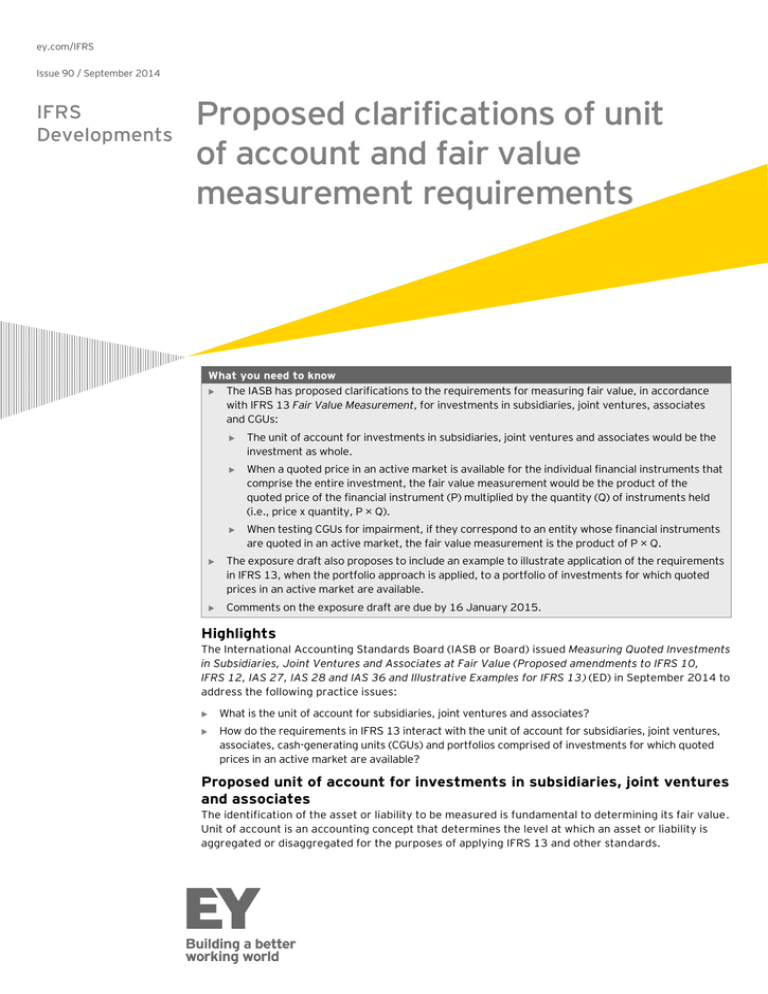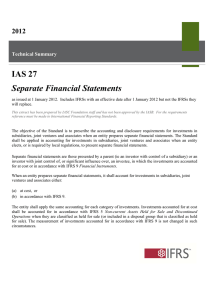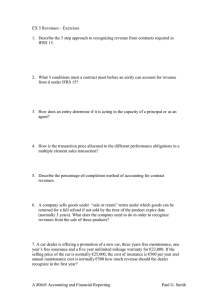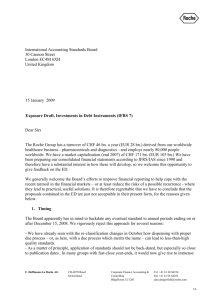
ey.com/IFRS
Issue 90 / September 2014
IFRS
Developments
Proposed clarifications of unit
of account and fair value
measurement requirements
What you need to know
The IASB has proposed clarifications to the requirements for measuring fair value, in accordance
with IFRS 13 Fair Value Measurement, for investments in subsidiaries, joint ventures, associates
and CGUs:
The unit of account for investments in subsidiaries, joint ventures and associates would be the
investment as whole.
When a quoted price in an active market is available for the individual financial instruments that
comprise the entire investment, the fair value measurement would be the product of the
quoted price of the financial instrument (P) multiplied by the quantity (Q) of instruments held
(i.e., price x quantity, P × Q).
When testing CGUs for impairment, if they correspond to an entity whose financial instruments
are quoted in an active market, the fair value measurement is the product of P × Q.
The exposure draft also proposes to include an example to illustrate application of the requirements
in IFRS 13, when the portfolio approach is applied, to a portfolio of investments for which quoted
prices in an active market are available.
Comments on the exposure draft are due by 16 January 2015.
Highlights
The International Accounting Standards Board (IASB or Board) issued Measuring Quoted Investments
in Subsidiaries, Joint Ventures and Associates at Fair Value (Proposed amendments to IFRS 10,
IFRS 12, IAS 27, IAS 28 and IAS 36 and Illustrative Examples for IFRS 13) (ED) in September 2014 to
address the following practice issues:
What is the unit of account for subsidiaries, joint ventures and associates?
How do the requirements in IFRS 13 interact with the unit of account for subsidiaries, joint ventures,
associates, cash-generating units (CGUs) and portfolios comprised of investments for which quoted
prices in an active market are available?
Proposed unit of account for investments in subsidiaries, joint ventures
and associates
The identification of the asset or liability to be measured is fundamental to determining its fair value.
Unit of account is an accounting concept that determines the level at which an asset or liability is
aggregated or disaggregated for the purposes of applying IFRS 13 and other standards.
Unless specifically addressed in IFRS 13, the appropriate unit of account is determined
by the standard that permits or requires the fair value measurement or disclosure.
The unit of account
for subsidiaries, joint
ventures and associates
would be the investment
as a whole.
For investments in subsidiaries, joint ventures and associates, an entity needs to look
to IFRS 10 Consolidated Financial Statements, IFRS 11 Joint Arrangements,
IAS 27 Separate Financial Statements and IAS 28 Investments in Associates and Joint
Ventures to determine the relevant unit of account. However, these standards do not
provide explicit guidance on the relevant unit of account. Furthermore, the
measurement requirements in IFRS 10, IAS 27 and IAS 28 refer to IFRS 9 Financial
Instruments, which permits or requires an investment to be accounted for in
accordance with that standard in certain circumstances. This has led to questions
about the extent to which the requirements of IFRS 9 apply. Would only the
measurement basis specified in IFRS 9 (i.e., fair value through profit or loss) apply or
would IFRS 9 also prescribe the unit of account (i.e., the individual financial
instruments that, in aggregate, comprise the investment as a whole)?
The Basis for Conclusions to the ED states that the unit of account for investments in
subsidiaries, joint ventures and associates would be the investment as whole, and not
the individual financial instruments (i.e., shares) that constitute the investment.
Interaction between unit of account and the measurement
requirements in IFRS 13
Investments in subsidiaries, joint ventures and associates
When an entity holds a position in a single asset or liability that is traded in an active
market (including a position comprising a large number of identical assets or
liabilities), IFRS 13 requires it to measure fair value using the quoted price without
adjustment. This requirement is accepted when the asset or liability being measured is
a financial instrument in the scope of IFRS 9 or IAS 39 Financial Instruments:
Recognition and Measurement.
However, when an entity holds an investment in a subsidiary, joint venture or
associate, current valuation techniques sometimes include an adjustment (e.g., a
control premium) to reflect, for example, the value of the investor’s control, joint
control or significant influence over the investee.
IFRS 13 requires entities to select inputs that are consistent with the characteristics
of the asset or liability being measured and that would be considered by market
participants when pricing the asset or liability. Apart from block discounts (which are
specifically prohibited), determining whether a premium or discount can be included in
a particular fair value measurement requires judgement and depends on specific facts
and circumstances.
IFRS 13 states that premiums or discounts should not be incorporated in fair value
measurements unless all of the following conditions are met:
The application of the premium or discount reflects the characteristics of the asset or
liability being measured
Market participants, acting in their economic best interest, would consider that
premium or discount when pricing the asset or liability
The inclusion of the premium or discount is not inconsistent with the unit of account in
the IFRS that requires or permits the fair value measurement
Therefore, if the unit of account is deemed to be the investment as a whole, it would
be appropriate to include, for example, a control premium when determining fair value,
provided that market participants take this into consideration when pricing the asset.
However, if a quoted price in an active market is available for individual shares in
the subsidiary, joint venture or associate, should the requirement to use P x Q
without adjustment to measure the fair value override the requirements relating to
premiums or discounts? This question is applicable even when the unit of account is
the entire investment.
2
Proposed clarifications of unit of account and fair value measurement requirements
If available, a Level 1
price would be used to
measure the fair value,
even when the reporting
entity has a controlling
interest.
The ED proposes that, for investments that are comprised of financial instruments for
which a Level 1 price is available, the requirement to use P x Q takes precedence
irrespective of the unit of account. Therefore, for all such investments, the fair value
measurement is the product of P x Q, even when the reporting entity has an interest
that gives it control, joint control or significant influence over the investee.
Impairment testing of investments that are quoted in an active market
When testing for impairment in accordance with IAS 36 Impairment of Assets, the
recoverable amount of an asset or CGU is the higher of its value in use and fair value
less costs of disposal. The fair value component of fair value less costs of disposal is
required to be measured in accordance with IFRS 13.
When the asset or CGU corresponds to an investment in a listed entity, the same issue
arises as to whether the requirement to use P x Q, without adjustment, to measure fair
value would apply. Consistent with the proposals for listed investments in subsidiaries,
associates and joint ventures, the ED proposes that the requirement to use P x Q would
also apply.
Portfolios comprised of instruments for which Level 1 prices are available
IFRS 13 provides an exception to its principles, allowing entities to measure a group of
financial instruments based on the price to sell (or transfer) its net position for a
particular risk exposure, if certain criteria are met (the portfolio approach).
There is some debate about whether IFRS 13 prescribes the unit of account in relation
to the portfolio approach. Some believe the portfolio approach effectively changes the
unit of account for any financial instruments within the portfolio(s) to the net exposure
of the portfolio to a particular risk. This may have a number of consequences. For
example, the entity may be able to include premiums or discounts in the fair value
measurement of the portfolio that are consistent with that unit of account, but not the
individual instruments that make up the portfolio. In addition, because the net
exposure for the identified group may not be actively traded (even though some
financial instruments within the portfolio may be) P x Q may not be applied to the
actively traded instruments within the portfolio. Others believe that the portfolio
approach does not override the unit of account as provided in IAS 39 or IFRS 9.
Therefore, any premiums or discounts that are inconsistent with this unit of account
would be excluded.
Regardless of which view is taken, it is clear in IFRS 13 that the portfolio approach
does not change the financial statement presentation requirements. As such, the use
of this approach may also require a reporting entity to allocate portfolio-level valuation
adjustments for disclosure purposes.
The ED proposes to include an example in IFRS 13 to illustrate application of the
portfolio approach to portfolios that are solely comprised of instruments for which
Level 1 prices are available. It does not address portfolios that include other financial
instruments for which Level 1 prices are not available. Nor does it illustrate how an
entity would allocate the measurement of a portfolio to the instruments within it for
disclosure purposes.
The illustrative example suggests that an entity would measure the net long or net
short position in accordance with the corresponding Level 1 prices. Furthermore, it
indicates that the resulting measurement could be achieved by measuring the net
position at the mid-price, adjusted by a bid-offer spread.
Proposed clarifications of unit of account and fair value measurement requirements
3
EY | Assurance | Tax | Transactions | Advisory
Proposed transition requirements
The IASB has proposed the following transition requirements:
For quoted investments in subsidiaries, joint ventures and associates, an entity would
recognise a cumulative catch-up adjustment to opening retained earnings for the period
in which the proposed amendments are first applied. The entity would then recognise
the change in measurement of the quoted investments during that period in profit or
loss (i.e., retrospective application).
For impairment testing in accordance with IAS 36, an entity would apply the
requirements on a prospective basis. If an entity incurs an impairment loss or reversal
during the period of initial application, it would provide quantitative information about
the likely effect on the impairment loss/reversal amount had the amendments been
applied in the immediately preceding period presented.
The ED clarifications regarding application of the portfolio approach could potentially
lead to a change practice for some entities. However, since the IASB has only proposed
the inclusion of an illustrative example, no transition requirements have been
proposed for the portfolio approach.
The ED does not include a proposed effective date. However, it permits early adoption.
Furthermore, a first-time adopter of IFRS would be able to apply the amendments at
the beginning of the earliest period for which it presents full comparative information
under IFRS in its first IFRS financial statements (i.e., prospectively from the date of the
first-time adopter’s transition to IFRS).
How we see it
The proposed amendments would provide useful clarifications of how the Board
views the interaction between unit of account and the requirements in IFRS 13 when
Level 1 prices are available. However, it is unclear why some of the proposed
clarifications would only be within the Basis for Conclusions or the Illustrative
Examples, rather than within the relevant standards.
While the proposed amendments for subsidiaries, joint ventures associates
and CGUs may be operationally simple for preparers to apply, the result may
be counterintuitive, particularly if they lead to additional impairment losses
being recognised.
Additional guidance may be needed to assist entities in applying the portfolio
approach to portfolios that include instruments for which quoted prices in an active
market are available and for portfolios that include some instruments for which
quoted prices in an active market are not available. For example, it is not clear
whether the analysis in the proposed example is intended to apply only to the fact
pattern illustrated or more broadly. In addition, it is not clear how this would interact
with the practical expedient in paragraph 71 of IFRS 13, which permits entities to
use mid-market pricing.
If the Board proceeds with the proposed amendments, they could have a significant
impact on entities, whether they are recognising their investments at fair value,
measuring the fair value of a portfolio, or using fair value measurement as part
of an impairment test. It is, therefore, unclear why the proposed transition
requirements include a mix of prospective and retrospective application and why no
transition requirements have been included in relation to the proposed clarifications
of the application of the portfolio approach in IFRS 13.
Next steps
Comments are due by 16 January 2015. We encourage constituents to take the
opportunity to respond to the Board.
About EY
EY is a global leader in assurance, tax,
transaction and advisory services. The insights
and quality services we deliver help build trust
and confidence in the capital markets and in
economies the world over. We develop
outstanding leaders who team to deliver on
our promises to all of our stakeholders. In so
doing, we play a critical role in building a
better working world for our people, for our
clients and for our communities.
EY refers to the global organization and may
refer to one or more of the member firms of
Ernst & Young Global Limited, each of which is
a separate legal entity. Ernst & Young Global
Limited, a UK company limited by guarantee,
does not provide services to clients. For more
information about our organization, please
visit ey.com.
About EY’s International Financial Reporting
Standards Group
A global set of accounting standards provides
the global economy with one measure to
assess and compare the performance of
companies. For companies applying or
transitioning to International Financial
Reporting Standards (IFRS), authoritative and
timely guidance is essential as the standards
continue to change. The impact stretches
beyond accounting and reporting, to key
business decisions you make. We have
developed extensive global resources — people
and knowledge — to support our clients
applying IFRS and to help our client teams.
Because we understand that you need a
tailored service as much as consistent
methodologies, we work to give you the
benefit of our deep subject matter knowledge,
our broad sector experience and the latest
insights from our work worldwide.
© 2014 EYGM Limited.
All Rights Reserved.
EYG No. AU2643
ED None
In line with EY’s commitment to minimize its impact on the
environment, this document has been printed on paper
with a high recycled content.
This material has been prepared for general informational
purposes only and is not intended to be relied upon as
accounting, tax, or other professional advice. Please refer
to your advisors for specific advice.
ey.com




